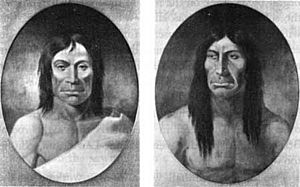Cayuse Five facts for kids
The Cayuse Five were five members of the Cayuse tribe from Oregon. They were put to death in 1850 after being accused of being involved in the death of Marcus Whitman, a Christian missionary. Their names were Clokomas, Isiaasheluckas, Kiamasumkin, Telakite, and Tomahas. The spelling of these names can sometimes be different in historical records.
Contents
Who Were the Cayuse Five?
The Cayuse Five were important figures in the history of the Cayuse tribe in the mid-1800s. They were members of a Native American community living in what is now Oregon. Their story is closely linked to a difficult period of history when American settlers were moving into the region.
The Whitman Mission and Its Challenges
Marcus Whitman was a doctor and a missionary who, along with his wife Narcissa, established the Whitman Mission in 1836. This mission was located near present-day Walla Walla, Washington, on Cayuse land. The missionaries aimed to teach Christianity to the Cayuse people and introduce them to American farming methods.
However, there were many differences between the Cayuse way of life and the settlers' ways. The Cayuse people had their own traditions, beliefs, and ways of using the land. As more settlers arrived, tensions grew over land, resources, and cultural misunderstandings.
The Events of 1847
In 1847, a serious measles epidemic spread through the region. Many Cayuse people became very sick and died, while many of the white settlers seemed to recover more often. The Cayuse people believed that Whitman, as a doctor, had powerful medicine. When their people continued to die, some Cayuse leaders began to suspect that Whitman was intentionally harming them or not doing enough to help.
This misunderstanding, combined with the ongoing tensions, led to a tragic event in November 1847. Marcus Whitman, his wife Narcissa, and several other people at the mission were killed. This event is often called the "Whitman Massacre."
The Aftermath and the Cayuse War
The deaths at the Whitman Mission quickly led to a conflict known as the Cayuse War. This war lasted for several years, from 1847 to 1855, between the Cayuse people and the new government of the Oregon Territory. The government demanded that those responsible for the deaths at the mission be brought to justice.
After some time, five Cayuse men — Clokomas, Isiaasheluckas, Kiamasumkin, Telakite, and Tomahas — surrendered to the authorities. They did this hoping it would bring an end to the war and protect their people.
The Trial and Its Outcome
The five Cayuse men were taken to Oregon City, Oregon, which was the capital of the Oregon Territory at the time. They were put on trial in 1850. The trial was a very important event, as it was one of the first major legal cases in the new Oregon Territory.
The trial was difficult because of cultural differences and language barriers. The Cayuse men did not have lawyers who fully understood their culture or could properly represent their side of the story. After the trial, all five men were found responsible for the deaths at the mission. They were then put to death by hanging in June 1850.
Legacy of the Cayuse Five
The story of the Cayuse Five is a sad and complex part of Oregon's history. It highlights the challenges and conflicts that arose as different cultures met and competed for land and resources. For the Cayuse people, these five men are remembered as individuals who made a great sacrifice for their community. Their story continues to be studied as a reminder of the difficult past and the importance of understanding different perspectives in history.


